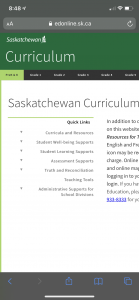Throughout this blog we will be discussing Mike Ribble’s nine elements of digital citizenship. It is a topic that needs to be integrated into the classroom. We will be looking at the Saskatchewan Curriculum to see what subjects and more specially the outcomes\indicators that connect to this important topic.
9 Elements of Digital Citizenship
According to Mike Ribble these things are essential to everything, we do in regards to Digital Citzenship.
1. Digital Access is about the equitable distribution of technology and online resources.
2. Digital Commerce is the electronic buying and selling of goods and focuses on the tools and safeguards in place.
3. Digital Communication and Collaboration – All users need to define how they will share their thoughts so that others understand the message.
4. Digital Etiquette refers to electronic standards of conduct or procedures and has to do with the process of thinking about others when using digital devices.
5. Digital Fluency is the process of understanding technology and its use.
6. Digital Health and Welfare refers to the physical and psychological well-being in a digital world.
7. Digital Law refers to the electronic responsibility for actions and deeds and has to do with the creation of rules and policy that address issues related to the online world.
8. Digital Rights and Responsibility are those requirements and freedoms extended to everyone in a digital world.
9. Digital Security and Privacy is the electronic precautions to guarantee safety.
Connections to the Curriculum

While looking at the curriculum I was able to find some outcomes and indicators in Grade 2 and 3 that directly or indirectly touch on the 9 elements.
ELA
CR3.1Comprehend and respond to a variety of grade-level texts (including contemporary and traditional visual, oral, written, and multimedia) that address: (I believe it can be shaped to teach towards most of the nine elements)
| (a) | View, listen to, read, and respond to a variety of texts that reflect the issues related to identity, community, and social responsibility and connect to personal experiences, other texts, and other areas of study. |
CR3.2 View and respond to grade-appropriate visual and multimedia texts (including videos, cartoons, illustrations, diagrams, charts, maps, and posters) explaining reactions and connections as well as visual features that convey humour, emotion, and mood. (Digital Access and Digital Communication and Collaboration)
| (f) | Describe perspectives or messages promoted by particular visual depictions in a film/video/DVD or magazine article. |
Health
USC2.1 Demonstrate a basic understanding of how thoughts, feelings, and actions influence health and well-being. Indicators (a, d, f) (Digital Health and Welfare and Digital Etiquette)
USC3.5 Evaluate safe behaviours/practices to increase the safety of self and others while at home. Indicators (a, c, h) (Digital Etiquette and Digital Health and Welfare, )
Social Studies
IN2.1 Determine characteristics of a community. (all Indicators) (Digital access, Digital Communication and Collaboration and Digital Rights and Responsibility)
| (f) | Identify characteristics common to local communities (e.g., transportation and communication networks, educational and health care systems, arts, culture, sport, and recreation infrastructure). |
It was hard to find curriculum connections for some of the nine elements of Digital Citizenship. Even though it might not be directly referenced in the curriculum. I am now more passionate in making sure that students understand what digital citizenship is and that they use it to their advantage. When we are using technology, I will take time and inform my students of content from the 9 Elements of Digital Citizenship when it flows into what we are doing . I also think that it is important for teachers to look at Digital Citizenship Continuum because it fills in the gaps that I could not see in the curriculum as I looked through it. I love that we are making strides in technology and education where we are putting out a document like this one. It can encourage and lead teachers that are uncertain about implementing technology into the classroom.